ICPR Brochures
Please click on the symbol in order to scroll through the brochure in your browser
Please use the link to download the file as pdf.
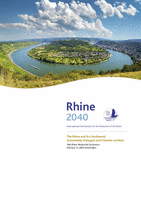
Rhine 2040 - long version
pdf
03/07/2022
bro_En_2040_long.pdf
Filesize: 6 MB
pages:
27
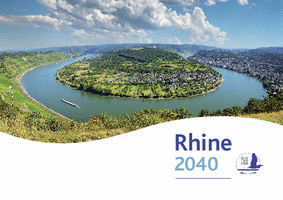
Rhine 2040 - short version
In 2020, the states in the Rhine catchment and the EU adopted the new programme "Rhine 2040" - for a sustainably managed and climate-resilient catchment. We would here like to briefly present the improvements already achieved in the past as well as the "Rhine 2040" programme with the planned measures.
pdf
01/11/2022
bro_En_2040_short.pdf
Filesize: 5 MB
pages:
7
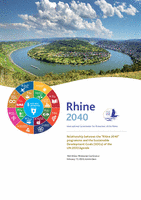
Relationship between the "Rhine 2040" programme and the Sustainable Development Goals (SDGs) of the UN 2030 Agenda
pdf
03/12/2020
bro_En_SDGs.pdf
Filesize: 5 MB
pages:
8
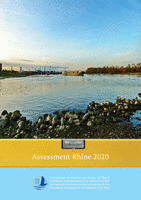
Assessment “Rhine 2020”
The implementation of the “Rhine 2020” programme, which has been ongoing since 2001, involves the further improvement of the Rhine ecosystem, including water quality, the reduction of flood risks and groundwater protection. “Rhine 2020” was supplemented by the resolutions of the Rhine Ministerial Conferences of 2007 and 2013 on the impact of climate change and the issues of low water and plastic waste. The Water Framework Directive (WFD - Directive 2000/60/EC) and the Flood Risk Management Directive (FD - Directive 2007/60/EC) have contributed significantly to the implementation of the ICPR programme.
The assessment clearly shows that many objectives of the "Rhine 2020" programme have been achieved or set in motion, but not all the objectives set at that time have been achieved in full. The goals that have not been achieved require further efforts as part of the implementation of the ICPR’s “Rhine 2040” programme. This also applies to new problems in the individual areas of ecology, water quality, flood and low water, taking into account the effects of climate change.
The assessment clearly shows that many objectives of the "Rhine 2020" programme have been achieved or set in motion, but not all the objectives set at that time have been achieved in full. The goals that have not been achieved require further efforts as part of the implementation of the ICPR’s “Rhine 2040” programme. This also applies to new problems in the individual areas of ecology, water quality, flood and low water, taking into account the effects of climate change.
pdf
02/13/2020
bro_En_Assessment_“Rhine_2020”.pdf
Filesize: 14 MB
pages:
40
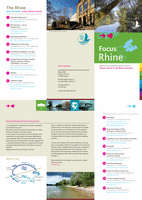
Focus Rhine
What can be experienced and where?
Visitors’ centres in the Rhine catchment
Visitors’ centres in the Rhine catchment
pdf
12/15/2017
bro_En_2017_Focus_Rhine.pdf
Filesize: 4 MB
pages:
2
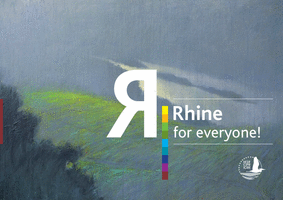
Rhine for everyone!
The Rhine
• is 1,233 km long and connects the Alps with the North Sea
• is an old settlement axis with rich urban culture since Roman times
• today represents the most important economic axis in Central Europe
• with its natural treasures and unique cultural landscapes it fascinates
visitors from all over the world
• and its tributaries cover a catchment area of about 200,000 km²
• all sources, brooks and rivers in this catchment pour into the North Sea
• 60 million people are living in the 9 states of this catchment
• 30 million people drink treated Rhine water.
30 years ago, following a chemical accident near Basel, life in the Rhine
was extinct along large stretches.
How clean is the Rhine today?
Which animals and plants are living in the Rhine today?
• is 1,233 km long and connects the Alps with the North Sea
• is an old settlement axis with rich urban culture since Roman times
• today represents the most important economic axis in Central Europe
• with its natural treasures and unique cultural landscapes it fascinates
visitors from all over the world
• and its tributaries cover a catchment area of about 200,000 km²
• all sources, brooks and rivers in this catchment pour into the North Sea
• 60 million people are living in the 9 states of this catchment
• 30 million people drink treated Rhine water.
30 years ago, following a chemical accident near Basel, life in the Rhine
was extinct along large stretches.
How clean is the Rhine today?
Which animals and plants are living in the Rhine today?
ISBN: 978-3-946755-24-1
pdf
03/27/2017
bro_En_2017_Rhine_for_everyone.pdf
Filesize: 6 MB
pages:
32
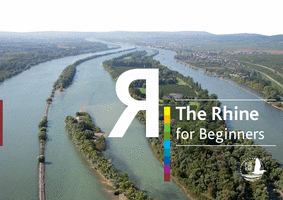
The Rhine for beginners
Water flows across the frontiers. 9 states share the Rhine catchment with its countless sources, brooks and tributaries.
The ICPR = International Commission for the Protection of the Rhine was founded in 1950. At first, it fought against the use of the Rhine as wastewater sewer. That was the main problem until the 1970s. As more and more wastewater treatment plants were built, the river recovered, but in 1986, a warehouse for chemicals of the Sandoz works near Basel in Switzerland burnt down. Highly toxic wastewater polluted with pesticides flowed into the Rhine, turned the river blood-red and caused fish death along several hundreds of kilometres.
For weeks, the riparian waterworks from Germany to the Netherlands could not use Rhine water for drinking water production.
The ICPR = International Commission for the Protection of the Rhine was founded in 1950. At first, it fought against the use of the Rhine as wastewater sewer. That was the main problem until the 1970s. As more and more wastewater treatment plants were built, the river recovered, but in 1986, a warehouse for chemicals of the Sandoz works near Basel in Switzerland burnt down. Highly toxic wastewater polluted with pesticides flowed into the Rhine, turned the river blood-red and caused fish death along several hundreds of kilometres.
For weeks, the riparian waterworks from Germany to the Netherlands could not use Rhine water for drinking water production.
ISBN: 978-3-946755-20-3
pdf
09/22/2016
bro_En_2016_The_Rhine_for_beginners.pdf
Filesize: 2 MB
pages:
9
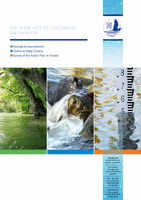
The Rhine and its catchment
This report presents an overview over ecological improvement along the River Rhine and its present chemical water quality. Furthermore, it contains a survey of the implementation of the Action Plan on Floods.
ISBN: 978-3-941994-46-1
pdf
09/26/2013
bro_En_2013_The_Rhine_and_its_catchment.pdf
Filesize: 2 MB
pages:
36
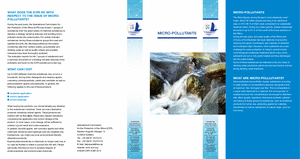
Micro-Pollutants
pdf
03/08/2013
bro_En_IKSR_Fly_Micro_2013.pdf
Filesize: 80 KB
pages:
2
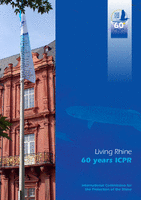
Living Rhine
60 years ICPR
pdf
07/01/2011
bro_En_2011_Living_Rhine.pdf
Filesize: 5 MB
pages:
16
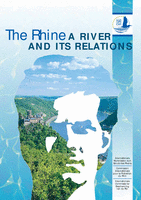
The Rhine A RIVER AND ITS RELATIONS
There are different reasons for why the Rhine developed into an economic axis in Europe. The decisive factors were above all the waterway and the Rhine as a source of water as raw material.
ISBN: 3-935324-63-4
pdf
12/08/2008
bro_En_2008_A_RIVER_AND_ITS_RELATIONS.pdf
Filesize: 4 MB
pages:
32
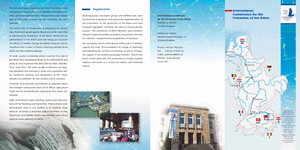
ICPR
For the benefit of the Rhine and of all of its tributaries the members of the International Commission for the Protection of the Rhine (ICPR). Focal points of this co-operation are the sustainable development of the Rhine, its floodplains and the good state of all waters in its watershed.
pdf
10/16/2007
bro_En_2007_ICPR.pdf
Filesize: 183 KB
pages:
2
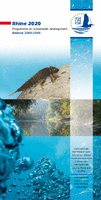
Rhine 2020
Programme on sustainable development
This balance presents a survey of progress achieved between 2000 and 2005 in four fields concerning the main stream of the Rhine.
This balance presents a survey of progress achieved between 2000 and 2005 in four fields concerning the main stream of the Rhine.
pdf
10/05/2007
bro_En_2007_Rhine_2020.pdf
Filesize: 600 KB
pages:
12
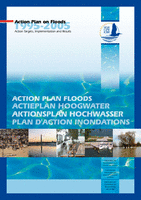
Action Plan on Floods
Action Targets, Implementation and Results
The Action Plan on Floods sets out the following targets for action: Reduce damage risks, Reduce flood levels, Increase flood awareness, Improve the flood announcement
system.
The Action Plan on Floods sets out the following targets for action: Reduce damage risks, Reduce flood levels, Increase flood awareness, Improve the flood announcement
system.
ISBN: 3-935324-63-4
pdf
09/27/2007
bro_En_2007_Action_Plan_on_Floods.pdf
Filesize: 822 KB
pages:
16

Atlas on the habitat patch connectivity along the Rhine
This brochure is available in German, French and Dutch.

Habitat patch connectivity along the Rhine
This brochure is available in German and French.
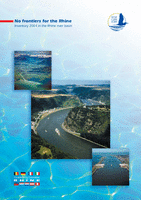
No frontiers for the Rhine
Inventory 2004 in the Rhine river basin
In 2004, a large scale inventory of the Rhine and the waters in its catchment was concluded. Nine states were involved in this work.
In 2004, a large scale inventory of the Rhine and the waters in its catchment was concluded. Nine states were involved in this work.
ISBN: 3-935324-53-7
pdf
06/24/2005
bro_En_2005_No_frontiers_for_the_Rhine.pdf
Filesize: 2 MB
pages:
12
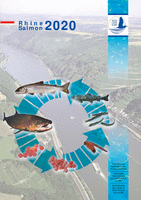
Rhine & Salmon 2020
"Salmon 2000" and its successful actions in favour of migratory fish is being continued in the 21st century. It is part of the new ICPR working programme "Rhine 2020“.
ISBN: 3-935324-51-0
pdf
12/02/2004
rp_En_0148.pdf
Filesize: 1 MB
pages:
32

Report accompanying the Rhine water structure map
This brochure is available in German and French.

Structure map 2003
This brochure is available in German, French and Dutch
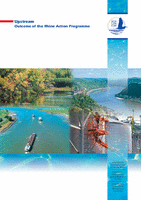
Upstream Outcome of the Rhine Action Programme
The Rhine Action Programme was extremely successful. There were several reasons for this success. The targets had been defined with precision.
The salmon proved to be a suitable draw. The Rhine Ministers in charge kept at it for 13 years.
The salmon proved to be a suitable draw. The Rhine Ministers in charge kept at it for 13 years.
ISBN: 3-935324-46-4
pdf
11/06/2003
bro_En_2003_Upstream_Outcome_of_the_Rhine.pdf
Filesize: 3 MB
pages:
31
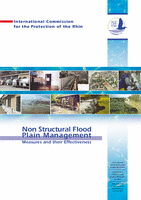
Non Structural Flood Plain Management
The report at hand presents general potential measures and assesses them with the aim of reducing flood damage hazards in different situations.
ISBN: 3-935324-47-2
pdf
02/26/2002
rp_En_0125.pdf
Filesize: 2 MB
pages:
50
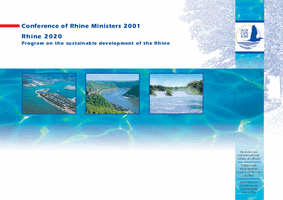
Conference of Rhine Ministers 2001
Rhine 2020 – Program on the sustainable development of the Rhine
ISBN: 3-935324-38-3
pdf
05/15/2001
rp_En_0116.pdf
Filesize: 4 MB
pages:
27






